A Novel Time-of-Use Pricing Based Energy Management System for Smart Home Appliances: Cost-Effective Method
Abstract
1. Introduction
2. Load Classification and Energy Tariffs
2.1. Domestic Devices Applied
2.2. Energy Tariff Scheme
3. Problem Development
3.1. The off and on Decision Variable
3.2. Limitations
3.2.1. Power Limitations
3.2.2. Solar Unit Production Limitation
3.2.3. Power Balance Limitation
3.2.4. Time Limitation
4. New Multi-Restricted Time Range Planning
5. Wind-Driven Optimization Algorithm
6. Simulation Results and Discussions
6.1. SAs Scheduled in a Constant Time Range
6.2. ScLAs (Scheduled Load Appliances) Using Restricted Time Range
6.3. ScLAs (Scheduled Load Appliances) Using Variable Time Planning
6.4. Constant Time-Range Planning Combined with PV
6.5. Restricted Time Scheduling Integrated with PV
6.6. Multi-Restricted Time Range Scheduling Integrated with PV
6.7. Variable Time Scheduling Integrated with PV
7. Conclusions
Author Contributions
Funding
Institutional Review Board Statement
Informed Consent Statement
Data Availability Statement
Acknowledgments
Conflicts of Interest
Nomenclature
| Energy cost. | |
| Fitness function. | |
| Number of controllable devices. | |
| The feed-in tariff. | |
| g | A constant value in the optimization algorithm. |
| The LOT meaning the energy usage of all appliances follows the appropriate schedule. | |
| , | The LOTs. |
| Energy usage of device at time slot in kWh. | |
| The minimal energy generation. | |
| The maximal energy generation by applying the PV system daily in the grid. | |
| A vector that represents the overall energy demand of SAs for every time slot . | |
| Load demand in every device in phase for time slot . | |
| and | The number of uncontrolled devices. |
| The optimum time for the function of the device . | |
| , | The probable start times in the range of the start and ending times of slot ranges. |
| / | The start time and end time for the device’s function in the consumer certain range. |
| Energy usage value hourly, at the time slot. | |
| The ‘on’ and ‘off’ binary decision variable. | |
| Vmax | Maximum velocity of the particle in the algorithm. |
| and | The beginning and ending time slots of the function of all appliances . |
| The energy generated via the rooftop solar PV system in time slot. | |
| The cycle count of a device in operation. | |
| , | The start time slots. |
| , | The ending time slots. |
References
- Sattar, S.; Niknam, T.; Nafar, M. A novel bio-inspired stochastic framework to solve energy management problem in hybrid AC-DC microgrids with uncertainty. Int. J. Bio-Inspired Comput. 2021, 18, 165–175. [Google Scholar]
- Dayalan, S.; Gul, S.S.; Rathinam, R.; Savari, G.F.; Aleem, S.H.E.A.; Mohamed, M.A.; Ali, Z.M. Multi-Stage Incentive-Based Demand Response Using a Novel Stackelberg–Particle Swarm Optimization. Sustainability 2022, 14, 10985. [Google Scholar] [CrossRef]
- Jokar, H.; Bahmani-Firouzi, B.; Simab, M. Bilevel model for security-constrained and reliability transmission and distribution substation energy management considering large-scale energy storage and demand side management. Energy Rep. 2022, 8, 2617–2629. [Google Scholar] [CrossRef]
- Al-Ghussain, L.; Ahmad, A.D.; Abubaker, A.M.; Abujubbeh, M.; Almalaq, A.; Mohamed, M.A. A Demand-Supply Matching-Based Approach for Mapping Renewable Resources Towards 100% Renewable Grids in 2050. IEEE Access 2021, 9, 58634–58651. [Google Scholar] [CrossRef]
- Hafeez, G.; Wadud, Z.; Khan, I.U.; Khan, I.; Shafiq, Z.; Usman, M.; Khan, M.U. Efficient energy management of IoT-enabled smart homes under price-based demand response program in smart grid. Sensors 2020, 20, 3155. [Google Scholar] [CrossRef] [PubMed]
- Veras, J.M.; Silva, I.R.S.; Pinheiro, P.R.; Rabêlo, R.A.L.; Veloso, A.F.S.; Borges, F.A.S.; Rodrigues, J.J.P.C. A Multi-Objective Demand Response Optimization Model for Scheduling Loads in a Home Energy Management System. Sensors 2018, 18, 3207. [Google Scholar] [CrossRef] [PubMed]
- Kou, X.; Li, F.; Dong, J.; Olama, M.; Starke, M.; Chen, Y.; Zandi, H. A Comprehensive Scheduling Framework Using SP-ADMM for Residential Demand Response With Weather and Consumer Uncertainties. IEEE Trans. Power Syst. 2020, 36, 3004–3016. [Google Scholar] [CrossRef]
- Hussain, H.M.; Javaid, N.; Iqbal, S.; Hasan, Q.U.; Aurangzeb, K.; Alhussein, M. An Efficient Demand Side Management System with a New Optimized Home Energy Management Controller in Smart Grid. Energies 2018, 11, 190. [Google Scholar] [CrossRef]
- Hafeez, G.; Islam, N.; Ali, A.; Ahmad, S.; Alimgeer, M.U.A.K.S. A Modular Framework for Optimal Load Scheduling under Price-Based Demand Response Scheme in Smart Grid. Processes 2019, 7, 499. [Google Scholar] [CrossRef]
- Zunnurain, I.; Maruf, N.I.; Rahman, M.; Shafiullah, G. Implementation of Advanced Demand Side Management for Microgrid Incorporating Demand Response and Home Energy Management System. Infrastructures 2018, 3, 50. [Google Scholar] [CrossRef]
- Karimi, H.; Niknam, T.; Dehghani, M.; Ghiasi, M.; Ghasemigarpachi, M.; Padmanaban, S.; Tabatabaee, S.; Aliev, H. Automated Distribution Networks Reliability Optimization in the Presence of DG Units Considering Probability Customer Interruption: A Practical Case Study. IEEE Access 2021, 9, 98490–98505. [Google Scholar] [CrossRef]
- Essiet, I.; Sun, Y.; Wang, Z. Scavenging differential evolution algorithm for smart grid demand side management. Procedia Manuf. 2019, 35, 595–600. [Google Scholar] [CrossRef]
- Bavafa, M.; Navidi, N.; Hesami, S.; Parsa, B.A. A new approach for Security Constrained Congestion Management using SSSC with Ant Colony Search Algorithm. In Proceedings of the 2010 Asia-Pacific Power and Energy Engineering Conference, Chengdu, China, 28–31 March 2010; pp. 1–5. [Google Scholar] [CrossRef]
- Awais, M.; Javaid, N.; Aurangzeb, K.; Haider, S.I.; Khan, Z.A.; Mahmood, D. Towards Effective and Efficient Energy Management of Single Home and a Smart Community Exploiting Heuristic Optimization Algorithms with Critical Peak and Real-Time Pricing Tariffs in Smart Grids. Energies 2018, 11, 3125. [Google Scholar] [CrossRef]
- Javaid, N.; Javaid, S.; Abdul, W.; Ahmed, I.; Almogren, A.; Alamri, A.; Niaz, I.A. A Hybrid Genetic Wind Driven Heuristic Optimization Algorithm for Demand Side Management in Smart Grid. Energies 2017, 10, 319. [Google Scholar] [CrossRef]
- Baroudi, U.; Bin-Yahya, M.; Alshammari, M.; Yaqoub, U. Ticket-based QoS routing optimization using genetic algorithm for WSN applications in smart grid. J. Ambient Intell. Humaniz. Comput. 2018, 10, 1325–1338. [Google Scholar] [CrossRef]
- Sarshar, J.; Moosapour, S.S.; Joorabian, M. Multi-objective energy management of a micro-grid considering uncertainty in wind power forecasting. Energy 2017, 139, 680–693. [Google Scholar] [CrossRef]
- Castillo, O.; Valdez, F.; Soria, J.; Yoon, J.H.; Geem, Z.W.; Peraza, C.; Ochoa, P.; Amador-Angulo, L. Optimal Design of Fuzzy Systems Using Differential Evolution and Harmony Search Algorithms with Dynamic Parameter Adaptation. Appl. Sci. 2020, 10, 6146. [Google Scholar] [CrossRef]
- Shareef, H.; Ahmed, M.S.; Mohamed, A.; Al Hassan, E. Review on home energy management system considering demand responses, smart technologies, and intelligent controllers. IEEE Access 2018, 6, 24498–24509. [Google Scholar] [CrossRef]
- Jang, M.; Jeong, H.C.; Kim, T.; Chun, H.-M.; Joo, S.-K. Analysis of Residential Consumers’ Attitudes Toward Electricity Tariff and Preferences for Time-of-Use Tariff in Korea. IEEE Access 2022, 10, 26965–26973. [Google Scholar] [CrossRef]
- Dutra, M.D.D.S.; Anjos, M.F.; Le Digabel, S. A realistic energy optimization model for smart-home appliances. Int. J. Energy Res. 2019, 43, 3237–3262. [Google Scholar] [CrossRef]
- Mohamed, M.A. A relaxed consensus plus innovation based effective negotiation approach for energy cooperation between smart grid and microgrid. Energy 2022, 252, 123996. [Google Scholar] [CrossRef]
- Essiet, I.O.; Sun, Y.; Wang, Z. Optimized energy consumption model for smart home using improved differential evolution algorithm. Energy 2019, 172, 354–365. [Google Scholar] [CrossRef]
- Rezaei, M.; Khalilpour, K.R.; Mohamed, M.A. Co-production of electricity and hydrogen from wind: A comprehensive scenario-based techno-economic analysis. Int. J. Hydrogen Energy 2021, 46, 18242–18256. [Google Scholar] [CrossRef]
- Tan, H.; Yan, W.; Ren, Z.; Wang, Q.; Mohamed, M.A. A robust dispatch model for integrated electricity and heat networks considering price-based integrated demand response. Energy 2022, 239, 121875. [Google Scholar] [CrossRef]
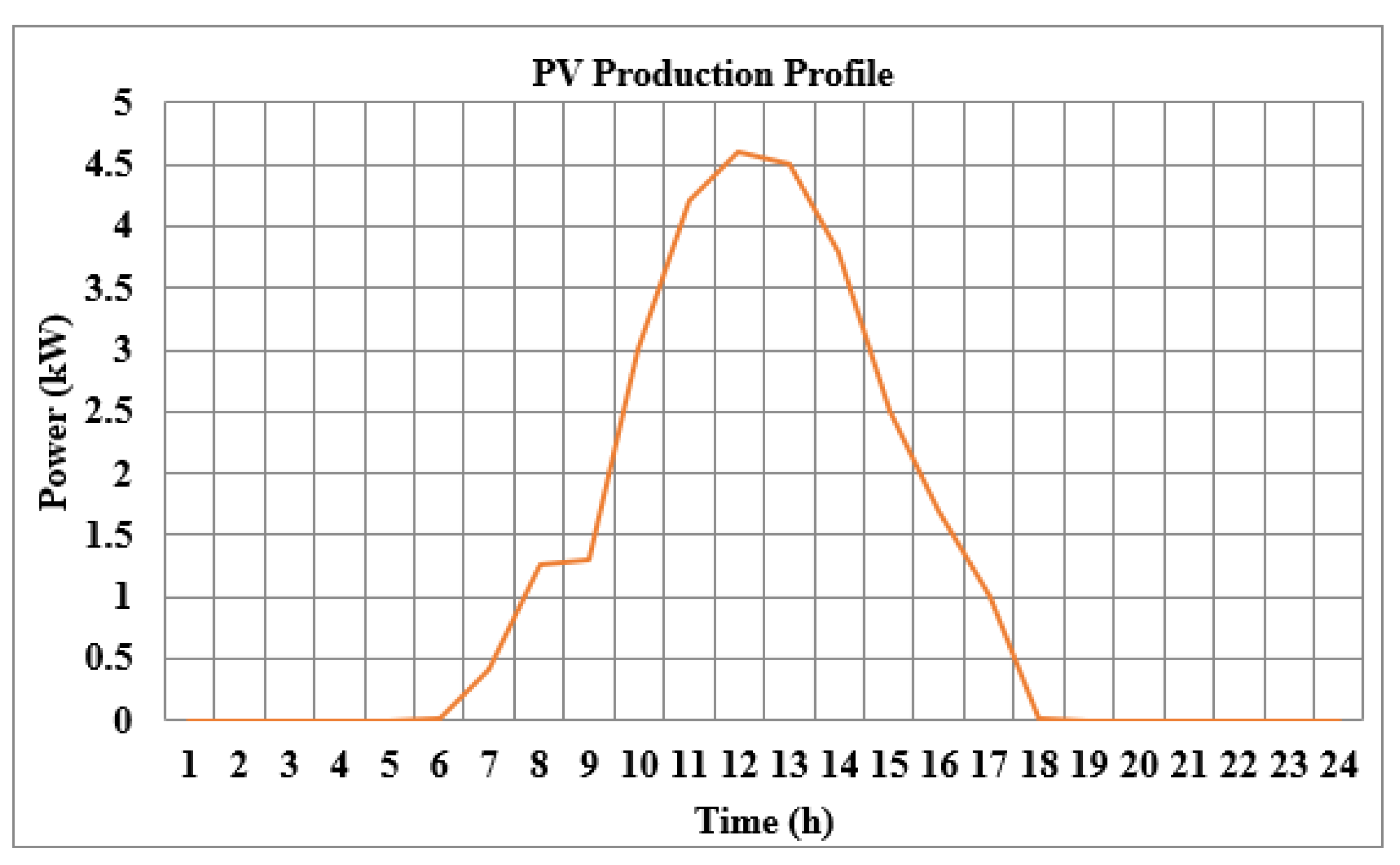
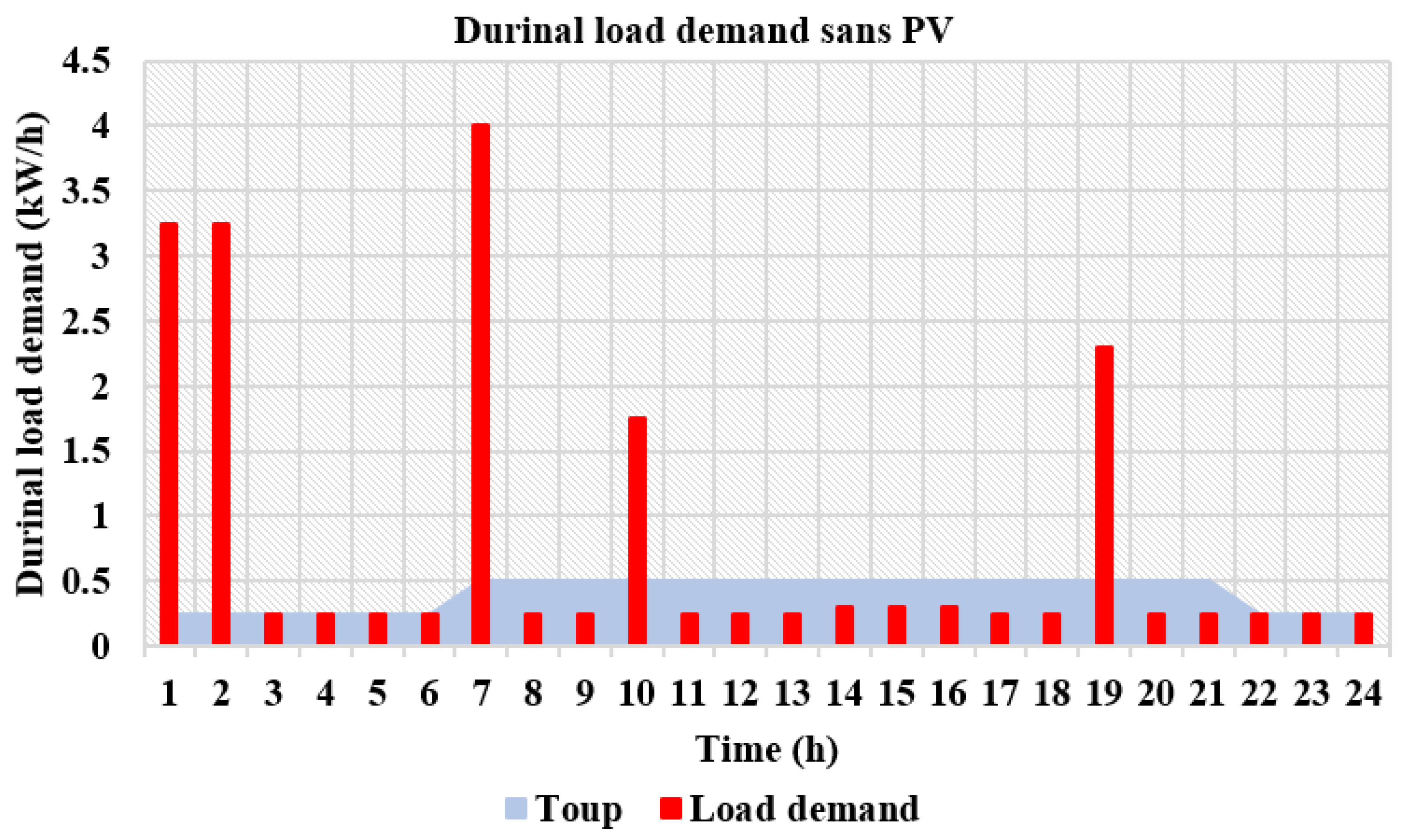

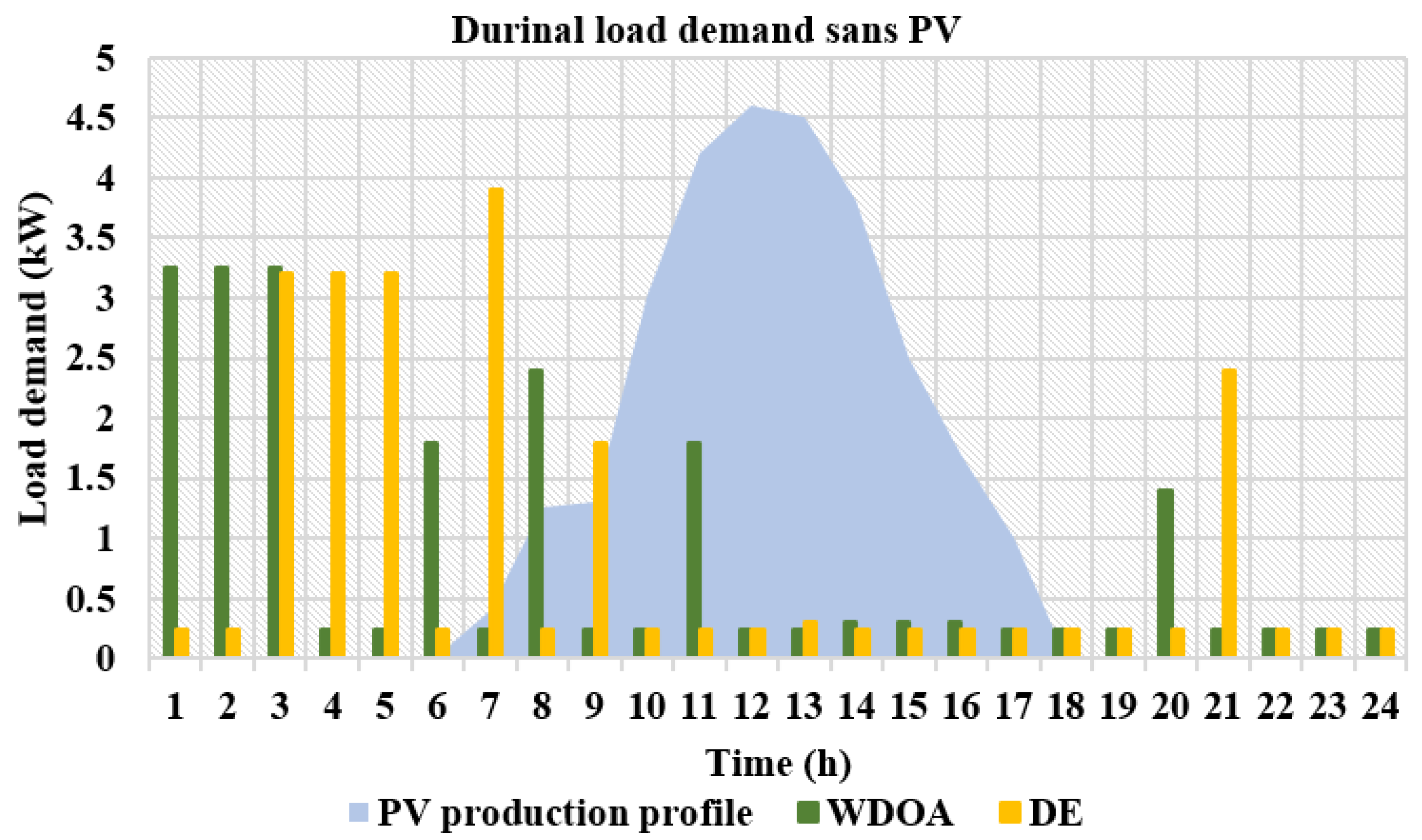
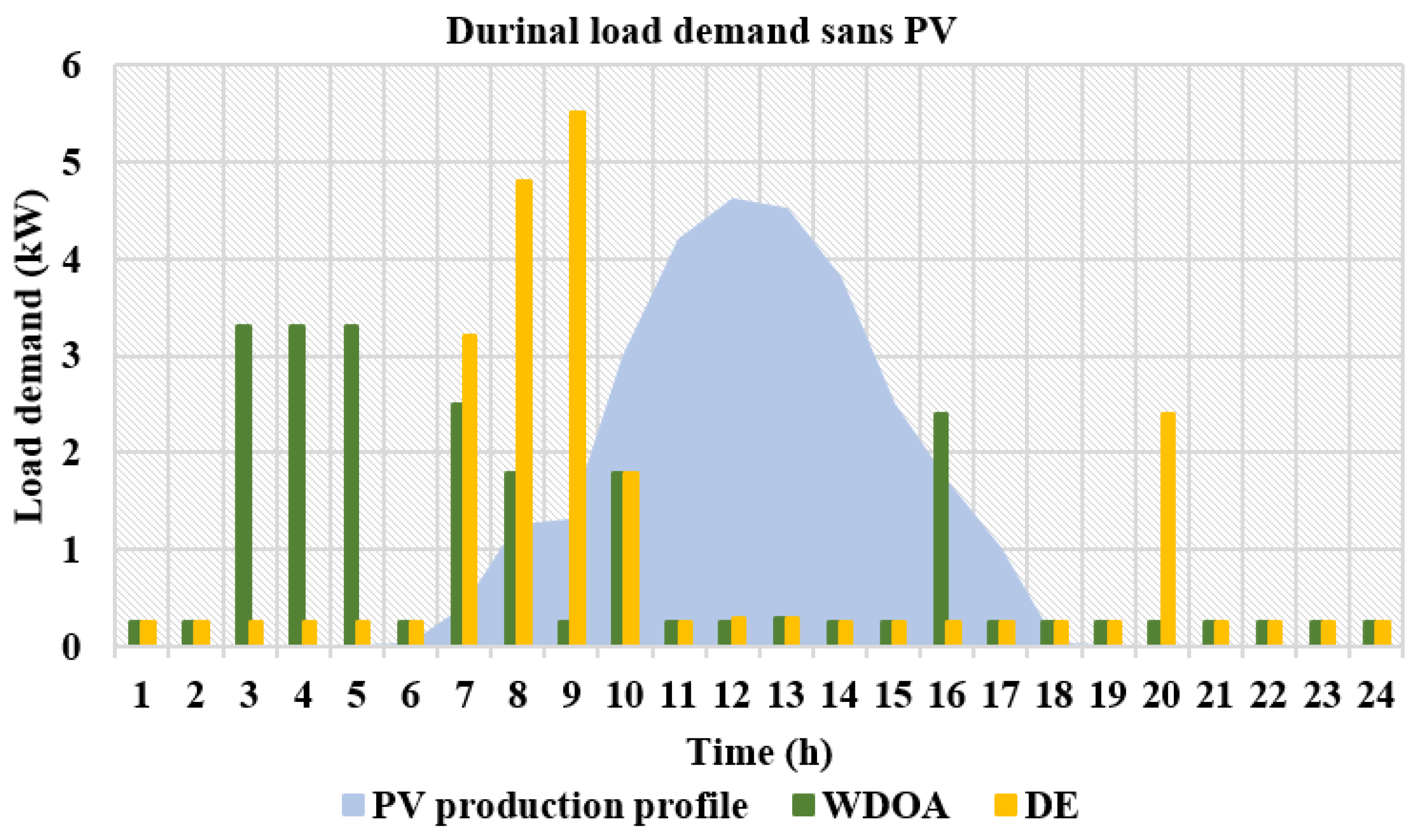
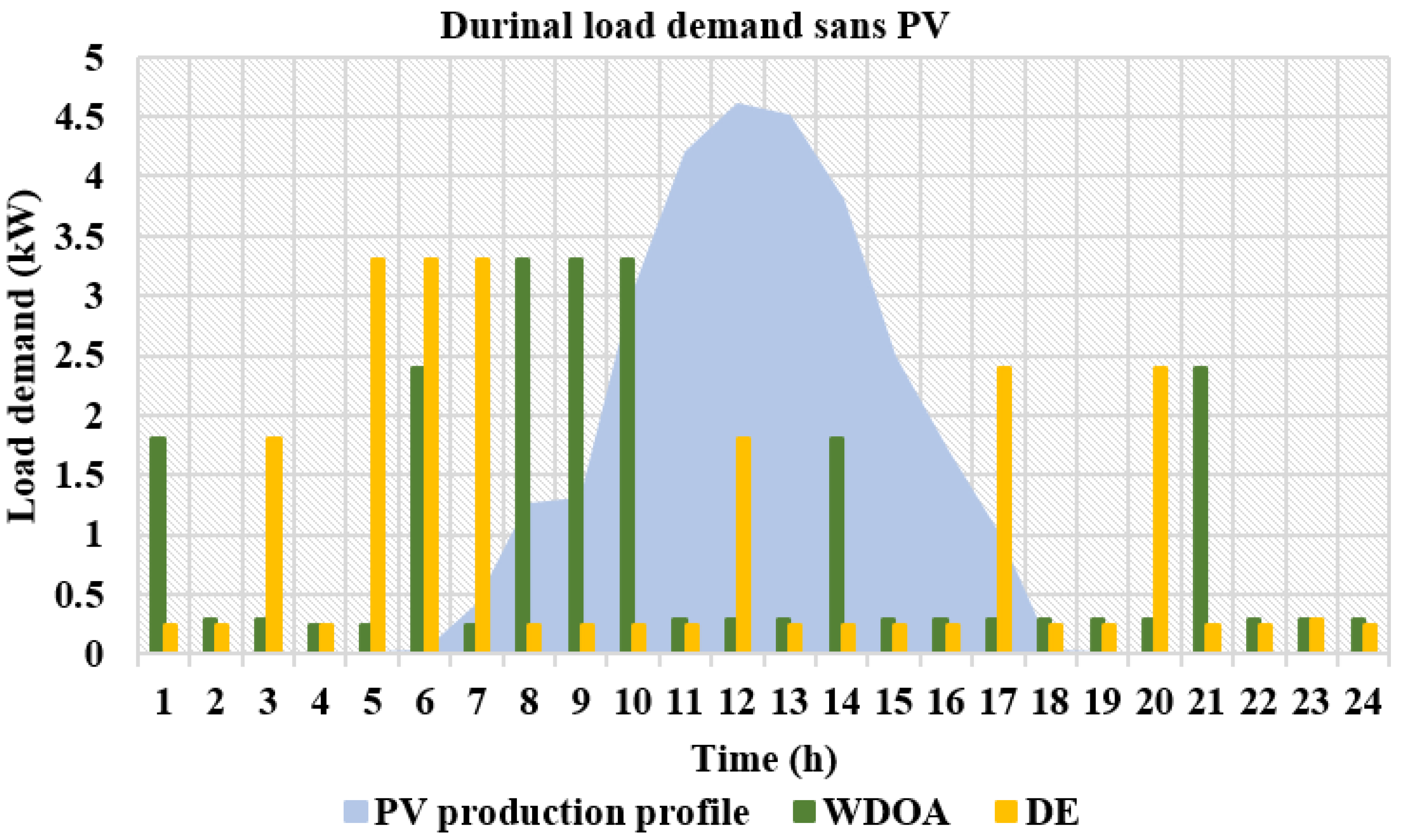
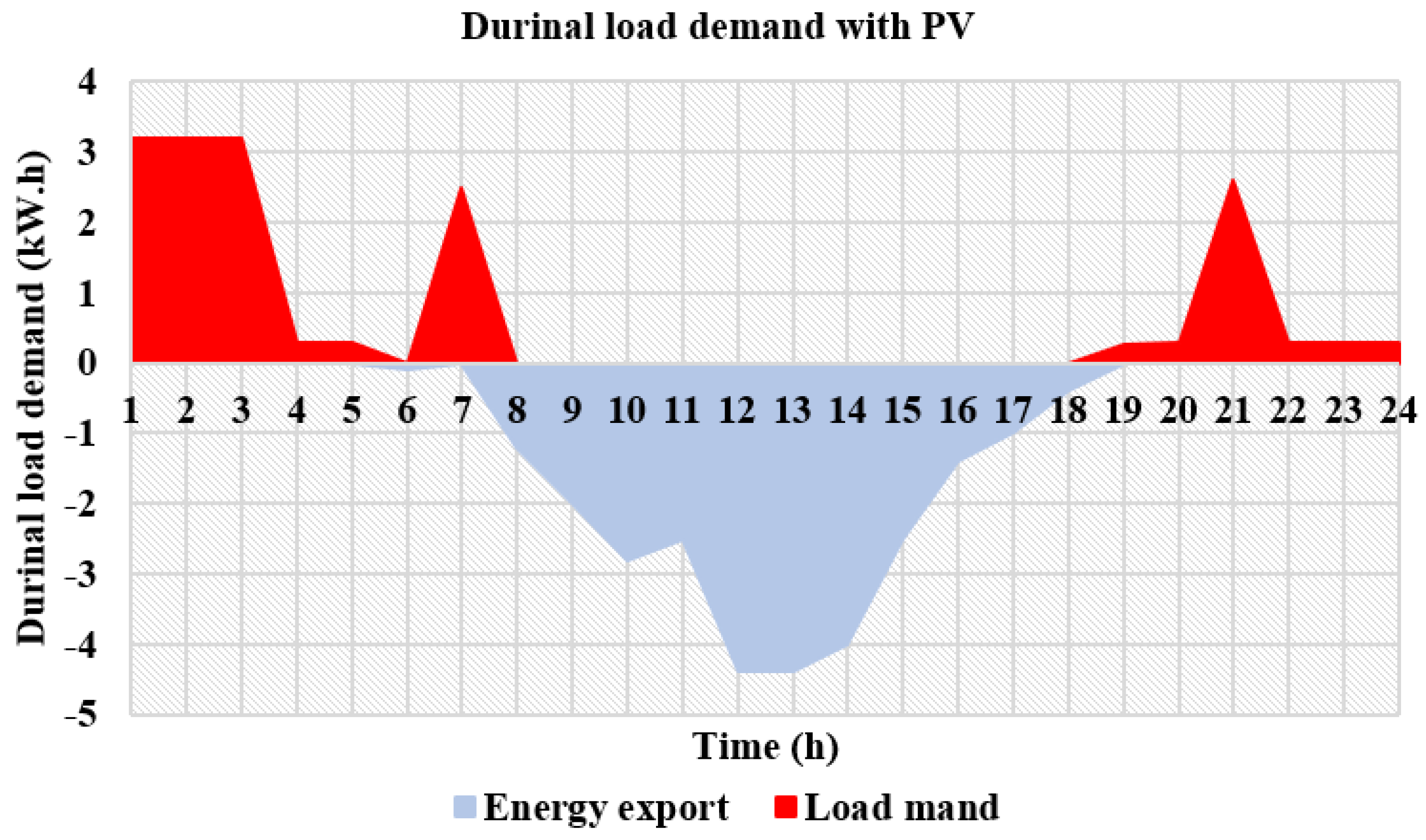
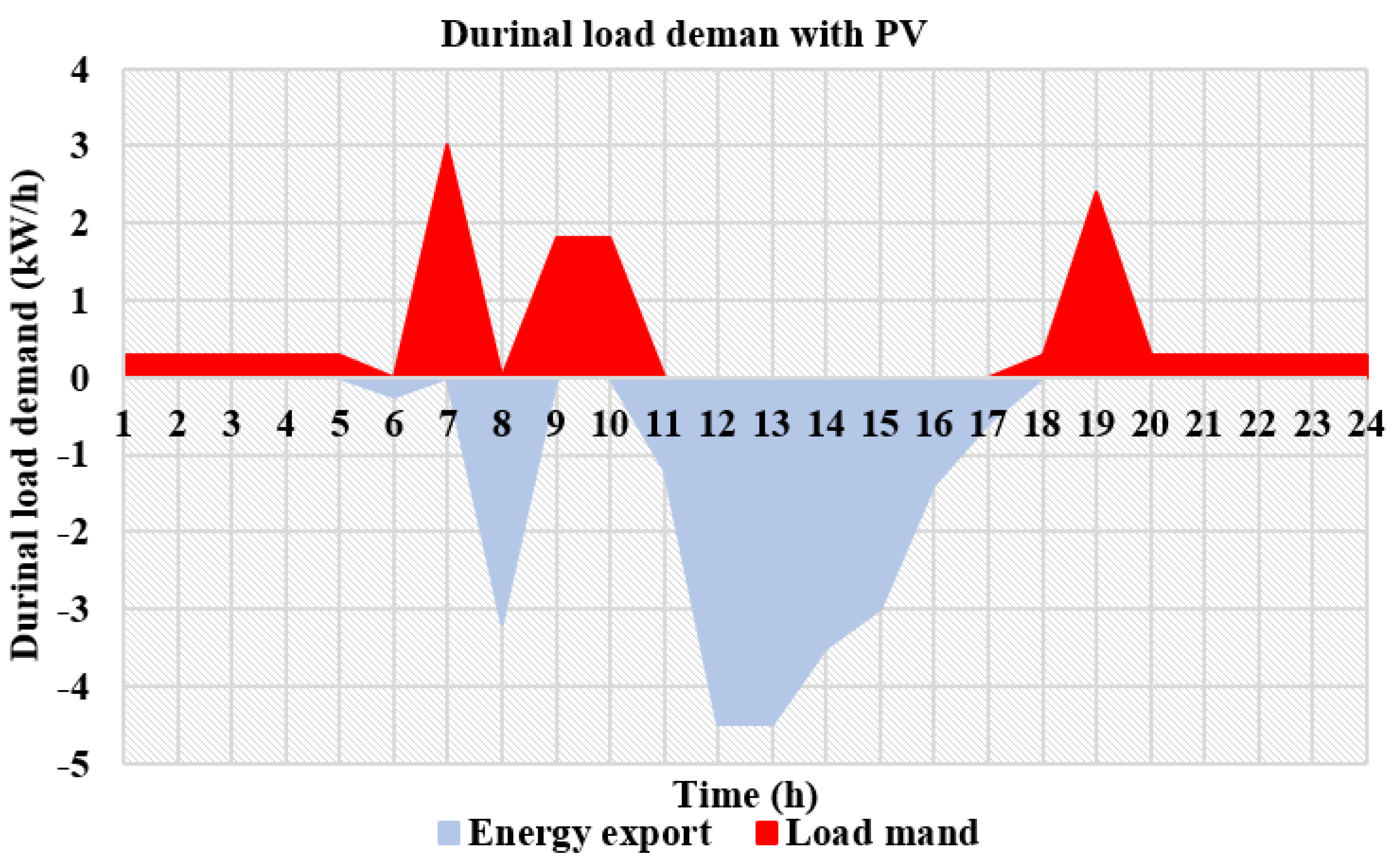
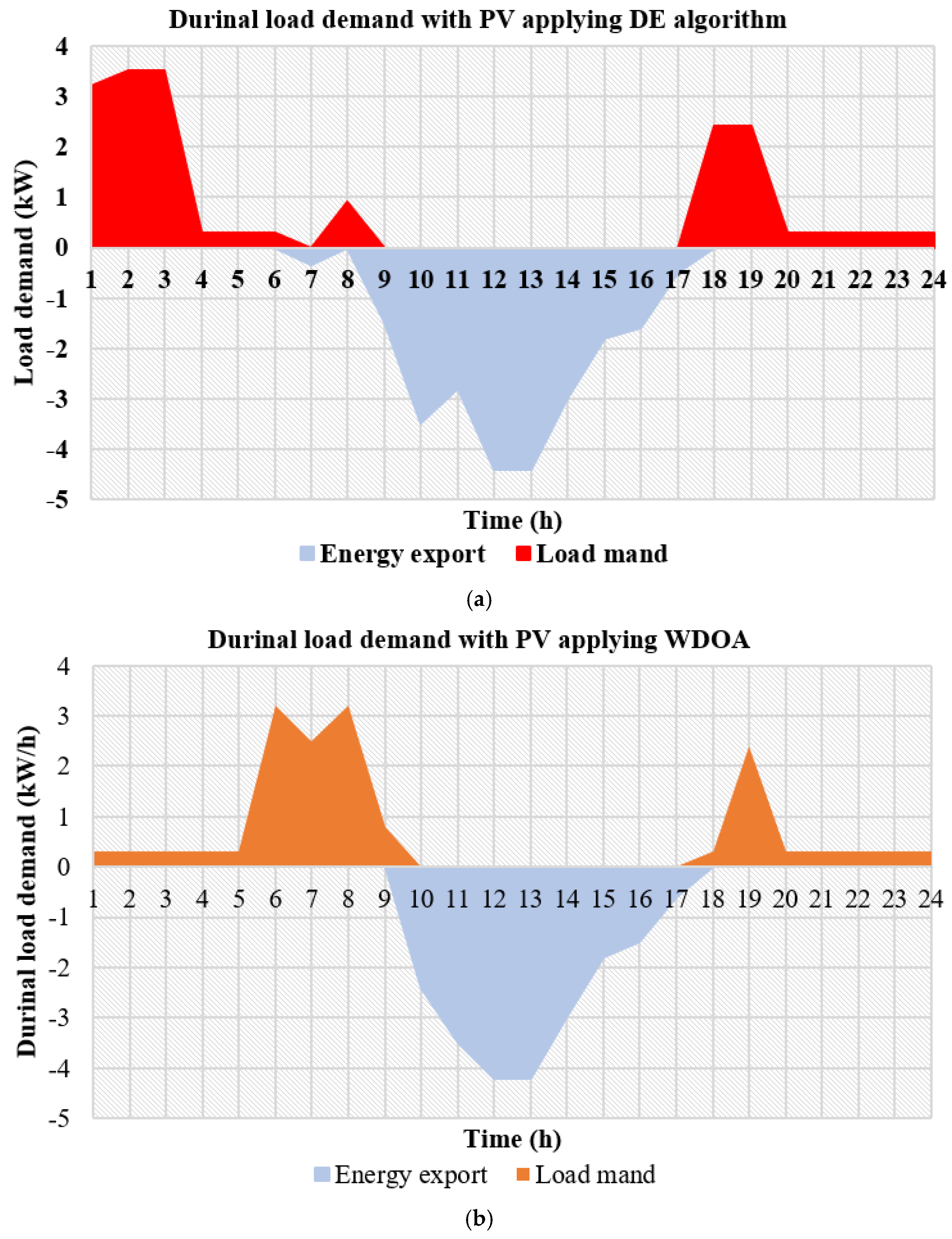
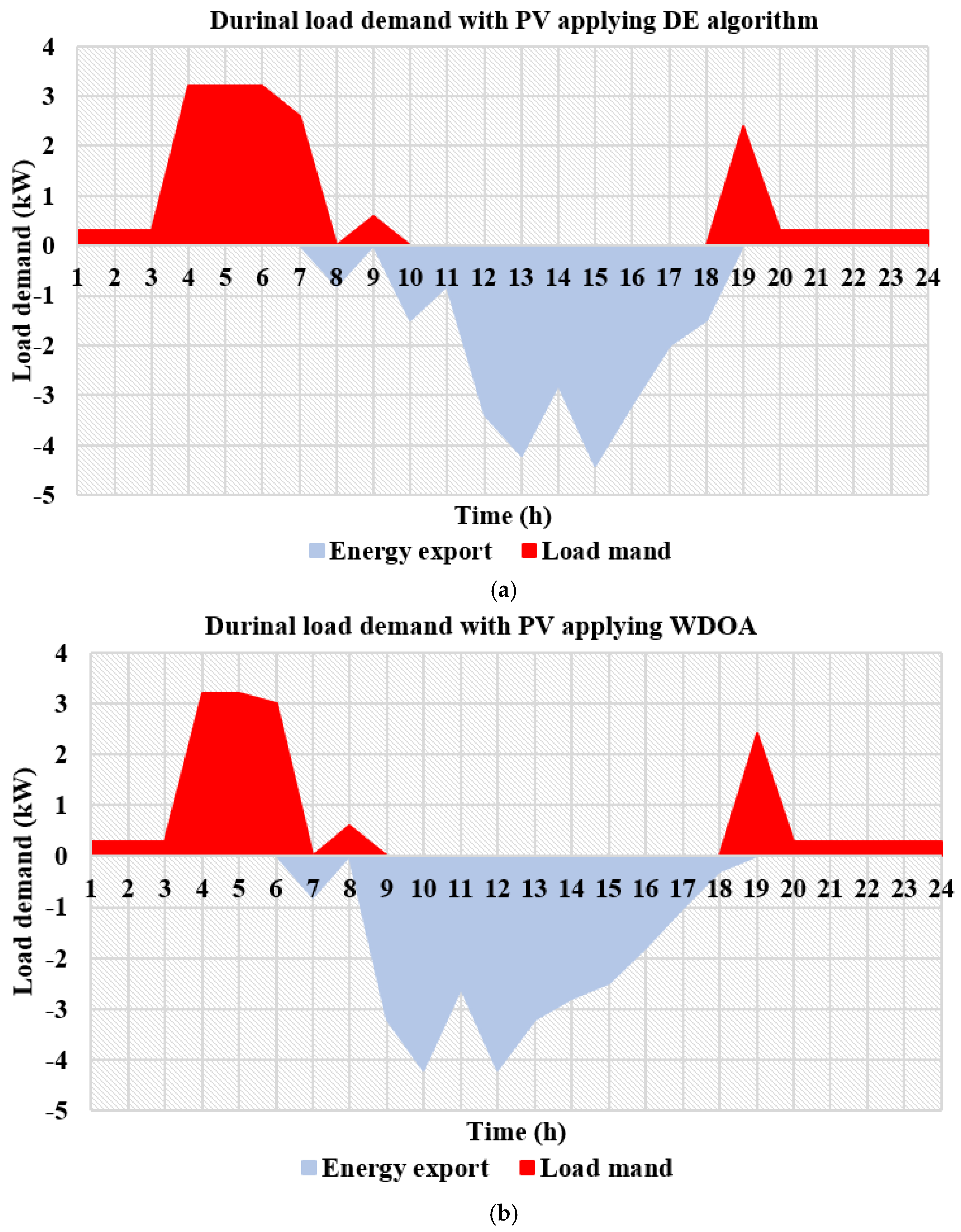
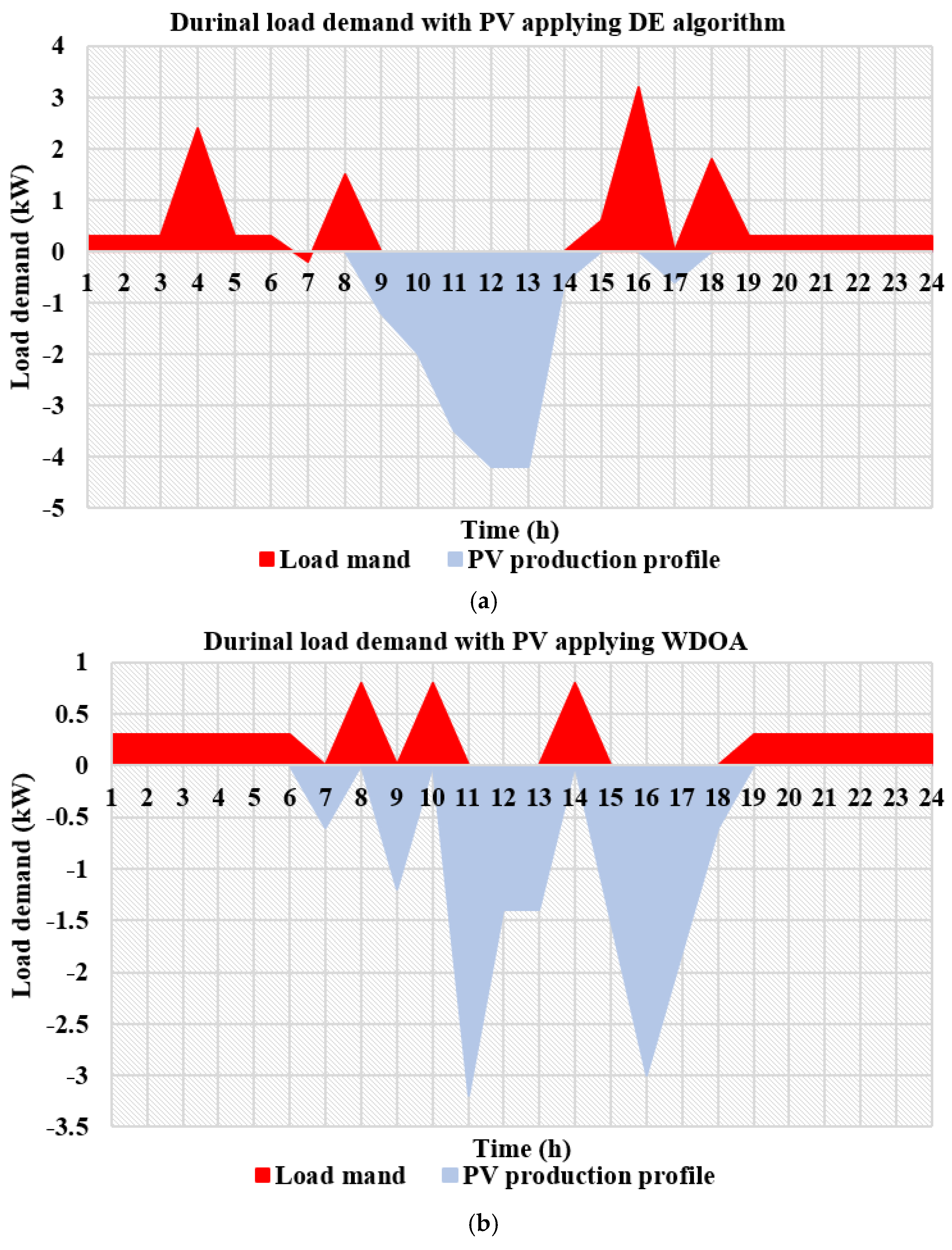
| Appliances | Washing Machine with Dryer | Refrigerator | Electric Iron | Electric Oven (Morning Hours) | Electric Oven (Evening Hours) | Water Heater | Table Fan | Coffee Grinder |
|---|---|---|---|---|---|---|---|---|
| Power rating (kW) | 0.225 | 1.5 | 2.15 | 2.15 | 1.5 | 0.025 | 0.1 | |
| Hours | 22:00–7:00 | 7:12–21:48 |
| Cost (TOUP) in USD/kWh | 0.00517 | 0.00775 |
| Devices | Coffee Grinder | Water Heater | Washing Machine with Dryer | Electric Iron | Table Fan | Electric Oven- (Morning Hours) | Electric Oven-2 (Morning Hours) | Refrigerator |
|---|---|---|---|---|---|---|---|---|
| Number of slots allocated | 1 | 5 | 15 | 2 | 10 | 4 | 4 | 115 |
| Power usage per day (kWh) | 0.02 | 1.5 | 9 | 0.6 | 0.05 | 1.72 | 1.72 | 5.172 |
| Real OTD (min) | 12 | 60 | 180 | 24 | 120 | 45 | 45 | 1380 |
| Power usage per day slot (kWh) | 0.02 | 0.3 | 0.6 | 0.3 | 0.05 | 0.43 | 0.43 | 0.045 |
| Power rate (kW) | 0.1 | 1.5 | 3 | 1.5 | 0.025 | 2.15 | 2.15 | 0.225 |
| Parameters | g | RT | Population Sizing | DimMax | |
|---|---|---|---|---|---|
| Amounts | 0.2 | 0.4 | 3 | 30 | 5 |
| Parameters | DimMin | Maximum iteration | |||
| Amounts | −5 | 0.1 | 0.9 | 200 | |
| Devices | Coffee Grinder | Water Heater | Washing Machine with Dryer | Electric Iron | Table Fan | Electric Oven-1 (Morning Hours) | Electric Oven-2 (Morning Hours) | Refrigerator |
|---|---|---|---|---|---|---|---|---|
| Number of slots allocated | 1 | 5 | 15 | 2 | 10 | 4 | 4 | 115 |
| OTI (time slot) | 62 | 51–55 | 1–15 | 37–38 | 71–80 | 36–39 | 97–100 | 1–115 |
| Starting Time (h) | 12-15 PM | 10-00 AM | 12-00 AM | 7-15 AM | 2-00 PM | 7-00 AM | 7-15 PM | 12-00 AM |
| Ending Time (h) | 12-20 PM | 11-00 AM | 2-48AM | 7-30AM | 3-00 PM | 7-45AM | 8-00 PM | 10-48 PM |
| Power usage per day slot (kWh) | 1 | 5 | 15 | 2 | 10 | 4 | 4 | 115 |
| Power rate (kW) | 0.1 | 1.5 | 3 | 1.5 | 0.025 | 2.15 | 2.15 | 0.225 |
| Interruptible Flexible Load Devices | ||||
|---|---|---|---|---|
| Appliances | Electric Iron | Coffee Grinder | Water Heater | Table Fan |
| Number of slots allocated | 2 | 1 | 5 | 10 |
| OTI | 33–42 | 59–68 | 46–55 | 65–80 |
| Power rate (kW) | 1.5 | 0.1 | 1.5 | 0.025 |
| Feasible operational starting and ending time (h) | 6:24–8:12 | 11:36–13:24 | 9:00–10:48 | 12:48–15:48 |
| Non-interruptible flexible load devices | ||||
| Appliances | Electric oven-1 | Electric oven-2 | Refrigerator | Washing machine with dryer |
| Number of slots allocated | 4 | 4 | 115 | 15 |
| OTI | 33–44 | 92–106 | 1–115 | 1–30 |
| Power rate (kW) | 2.15 | 2.15 | 0.225 | 3 |
| Feasible operational starting and ending time (h) | 6:24–8:36 | 18:12–21:00 | 12:00–22:48 | 00:00–5:48 |
| Schedulable Devices | Washing Machine with Dryer | Water Heater | Table Fan | Electric Oven-1 | Electric Oven-2 | Refrigerator | Electric Iron |
|---|---|---|---|---|---|---|---|
| Number of slots allocated | 15 | 5 | 10 | 4 | 4 | 115 | 2 |
| OTI (time slot) | 1–17 or 19–34 | 41–48 or 50–60 | 61–70 or 72–81 | 31–35 or 41–49 | 86–92 or 97–101 | 1–115 | 31–36 or 39–43 |
| Power rate (kW) | 3 | 1.5 | 0.025 | 2.15 | 2.15 | 0.225 | 1.5 |
| Feasible operational starting and ending time (h) | 00:00–3:12 or 3:36–6:36 | 8:00–9:24 or 9:48–11:48 | 12:00–13:48 or 14:12–16:00 | 6:00–6:48 or 8:00–9:36 | 17:00–18:12 or 19:12–20:00 | 12:12–23:48 | 6:00–7:00 or 7:36–8:24 |
| Devices | Washing Machine with Dryer | Water Heater | Coffee Grinder | Table Fan | Electric Oven-1 | Electric Oven-2 | Refrigerator | Electric Iron |
|---|---|---|---|---|---|---|---|---|
| Number of slots allocated | 15 | 5 | 1 | 10 | 4 | 4 | 115 | 2 |
| OTI (time slot) | 1–120 | 1–120 | 1–120 | 1–120 | 1–120 | 1–120 | 1–120 | 1–120 |
| Power usage per day (kWh) | 9 | 1.5 | 0.02 | 0.05 | 1.72 | 1.72 | 5.17 | 0.6 |
| Number of exiting operational cycles | 106 | 116 | 120 | 111 | 117 | 117 | 6 | 119 |
| Power usage per slot (kWh) | 0.6 | 0.3 | 0.02 | 0.005 | 0.43 | 0.43 | 0.045 | 0.3 |
| Devices | Unplanned | Fixed Time Planning | ||
|---|---|---|---|---|
| Operational layout | System using PV | System sans PV | System using PV | System sans PV |
| PAR | 3.75 | 5.73 | 3.91 | 4.70 |
| Peak load | 3.09 | 4.73 | 3.23 | 3.88 |
| Power price (USD/day) consumer paid for grid | 0 | 0.148 | 0 | 0.124 |
| Power price (USD/day) grid paid for consumer | 0.072 | 0 | 0.74 | 0 |
Publisher’s Note: MDPI stays neutral with regard to jurisdictional claims in published maps and institutional affiliations. |
© 2022 by the authors. Licensee MDPI, Basel, Switzerland. This article is an open access article distributed under the terms and conditions of the Creative Commons Attribution (CC BY) license (https://creativecommons.org/licenses/by/4.0/).
Share and Cite
Alsokhiry, F.; Siano, P.; Annuk, A.; Mohamed, M.A. A Novel Time-of-Use Pricing Based Energy Management System for Smart Home Appliances: Cost-Effective Method. Sustainability 2022, 14, 14556. https://doi.org/10.3390/su142114556
Alsokhiry F, Siano P, Annuk A, Mohamed MA. A Novel Time-of-Use Pricing Based Energy Management System for Smart Home Appliances: Cost-Effective Method. Sustainability. 2022; 14(21):14556. https://doi.org/10.3390/su142114556
Chicago/Turabian StyleAlsokhiry, Fahad, Pierluigi Siano, Andres Annuk, and Mohamed A. Mohamed. 2022. "A Novel Time-of-Use Pricing Based Energy Management System for Smart Home Appliances: Cost-Effective Method" Sustainability 14, no. 21: 14556. https://doi.org/10.3390/su142114556
APA StyleAlsokhiry, F., Siano, P., Annuk, A., & Mohamed, M. A. (2022). A Novel Time-of-Use Pricing Based Energy Management System for Smart Home Appliances: Cost-Effective Method. Sustainability, 14(21), 14556. https://doi.org/10.3390/su142114556












